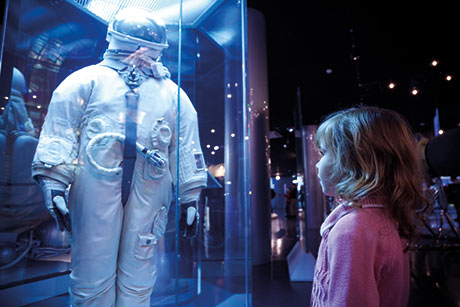
Download the PDF of Essential experiences...visitng museums
Dotted around our towns and cities are collections of objects housed in museums. Years ago, going to a museum for an afternoon or a day out was a fairly commonplace activity for families. By looking at local objects or collections of artefacts, children can see another perspective on the world around them. For some children, being introduced early on to artefacts may influence their later choice of career or give them a lifetime hobby.
BENEFITS
As well as visiting a museum, ideally we should help children to collect and group objects – activities that have many developmental benefits for young children:
Language development By going somewhere new, children are likely to want to talk about what they are seeing at the time. They may also ask questions about items and learn vocabulary associated with the items on display. When children create their own collections of objects, they can talk about what they are collecting, where they have found objects and why they have chosen them.
Understanding the World Going to a museum can draw children’s attention to things that they have seen before such as badges from motor cars or buckles from clothing. When it comes to museums that contain everyday objects, children can start to make the connection between past and present through objects such as toys, shoes and pottery.
Cognitive development If children go on to develop their own collections, they can be supported to develop decision-making skills that involve logic. Choosing which object should be included and where it should be placed requires higher-level thinking skills and so can help children become more logical thinkers.
Emotional development Children’s confidence can be boosted if they are able to be ‘experts’ and provide information to others. By talking to adults about what they have seen or by showing their ‘collections’, they can develop pride and competency.
PLANNING A PROGRAMME
It is worth spending a little time working out which museums are in your local area and are also in places where you can travel to easily. Most museums are free or have special rates for groups of children.
It is also worth thinking about some of the smaller museums that may be partly run be volunteers. The advantage of a small museum is that it may not require a whole day or even session out of the nursery and, because the collections will be limited, the children will be able to focus more easily on the items. Many smaller museums have local artefacts or are specialised in items such as clocks, needlework and toys.
Increasingly museums have outreach programmes so that either before or after the visit, the children’s learning can continue.

Practical matters
As with any visit, it is important to do a risk assessment and think about what in the museum’s collection might be of interest to the children. Also check if anyone will be able to show you round when you go with the children.
Having said this, it is a good idea not to ‘over-structure’ a visit, as quite often children may want to just spend a long time looking at three or four things and then skip by others.
Developing children’s interests
You can build on a museum visit in a variety of ways. You could start off by creating a role-play area with the children. This would include deciding what would be displayed, creating labels and also having an entrance booth.
In addition, you could help individual children to develop their own collections of objects based on things that currently fascinate them. This could include items such as stones, wrappers or buttons. With the children you can classify them, photograph them and think about how best to store them.
Children can also take turns to show their ‘collections’ to adults and other children.
HOME LEARNING
While some parents will take their children to museums regularly, this is not the case with all families. Some parents may not even know that local museums exist, or that in the case of public-funded ones, that they are free. Ideally, it would be good to encourage parents to come along when you visit a museum, but if not, you can help them to build upon the experience by taking plenty of photographs and maybe also provide them with museum leaflets. You can also talk to parents about how they may want to encourage their child to become a ‘collector’.









